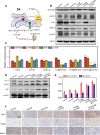Development of a pH-responsive polymersome inducing endoplasmic reticulum stress and autophagy blockade
- PMID: 32789182
- PMCID: PMC7399484
- DOI: 10.1126/sciadv.abb8725
Development of a pH-responsive polymersome inducing endoplasmic reticulum stress and autophagy blockade
Abstract
Autophagy is involved in the occurrence and development of tumors. Here, a pH-responsive polymersome codelivering hydroxychloroquine (HCQ) and tunicamycin (Tuni) drugs is developed to simultaneously induce endoplasmic reticulum (ER) stress and autophagic flux blockade for achieving an antitumor effect and inhibiting tumor metastasis. The pH response of poly(β-amino ester) and HCQ synergistically deacidifies the lysosomes, thereby blocking the fusion of autophagosomes and lysosomes and lastly blocking autophagic flux. The function mechanism of regulating autophagy was systematically investigated on orthotopic luciferase gene-transfected, 4T1 tumor-bearing BALB/c mice through Western blot and immunohistochemistry analyses. The Tuni triggers ER stress to regulate the PERK/Akt signaling pathway to increase the autophagic level. The "autophagic stress" generated by triggering ER stress-induced autophagy and blocking autophagic flux is effective against tumors. The reduced expression of matrix metalloproteinase-2 due to ER stress and reduced focal adhesions turnover due to the blockade of autophagic flux synergistically inhibit tumor metastasis.
Copyright © 2020 The Authors, some rights reserved; exclusive licensee American Association for the Advancement of Science. No claim to original U.S. Government Works. Distributed under a Creative Commons Attribution NonCommercial License 4.0 (CC BY-NC).
Figures






References
Publication types
LinkOut - more resources
Full Text Sources
Other Literature Sources

